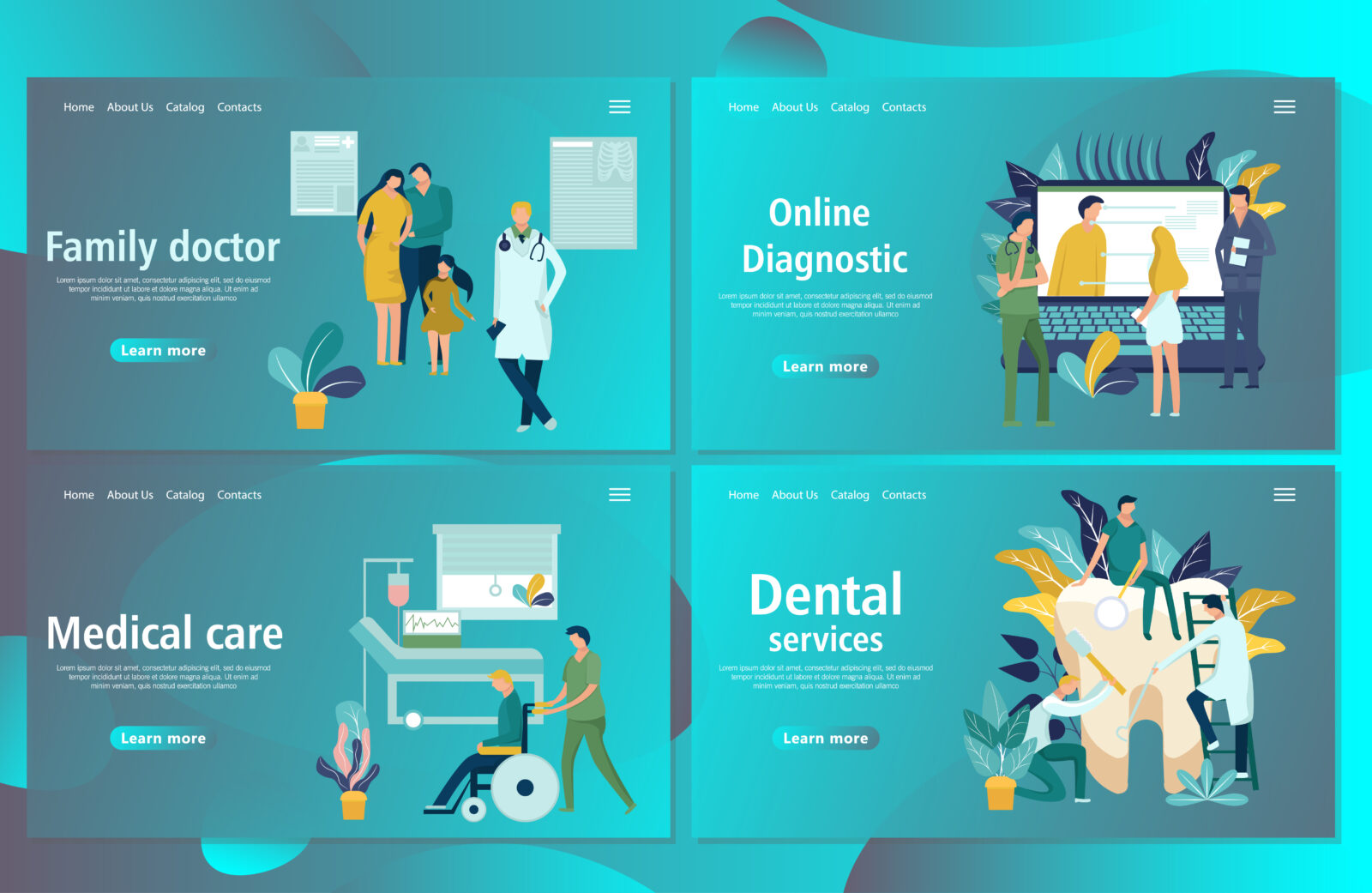Solid Key Website Elements to Include In Your Web Design
Websites offer the first point of interaction between healthcare providers and potential patients, so using key website elements effectively, especially in today’s digital age of technology. An effective healthcare website means that your website is not only functional, engaging, trustworthy, and reflective of your expertise and values. It means deeply understanding your audience’s needs and tailoring your website’s design and content to those concerns. If you’re looking to have and develop a successful healthcare website, then this article will dissect the anatomy of an effective healthcare website, exploring the key elements that can make your website work for you.
The Basic Key Website Elements of Healthcare Websites
Having a successful, robust healthcare website means making your website a profile for your practice and a comprehensive tool to meet the needs of your patients seeking information, services, and reassurance. A successful website is intuitive, functions seamlessly, and provides a clear understanding of how you can help them. Your website should be a welcoming, professional online space that reflects the care and expertise of your practice, and to create that, your website should have some essential components it, which include the following:

Logo Design
Your logo should be the first thing people notice about your website, as it is a critical aspect of your online identity. A well-designed logo should be simple to recognize and memorable and should be a visual element on every page. Your logo reinforces your brand identity and provides consistency across your website.
Website Color
Color theory is vital for any good web design, as colors evoke emotions, set the mood, and impact how visitors perceive your website. For healthcare websites, try to choose colors that match the logo and practice and convey the sentiments you wish to give to your patients. Some colors, such as blues, are highly recognizable for healthcare, but other colors, such as red, green, and soft neutrals, can help personalize your website while creating a sense of trust and professionalism. Your color palette should contribute to your practice by aligning with its tone and values.
Clear Vision and Mission
Your website should clearly state that you are a healthcare practice, and that includes your practice’s mission and values. Having a clear, inspiring mission statement and vision can help your patients better understand the values that drive your practice forward and help foster a deeper connection and trust between you and your patients.
Easy to Navigate
A website that’s clunky and difficult to load can be difficult to navigate and can frustrate your visitors. An effective healthcare website should have a clear, intuitive layout that allows patients to easily find the information they need, such as your services, practitioner details, and how to make appointments. Including a search function and a well-organized menu can enhance your user’s experience and make your website more engaging and valuable.
Practitioners’ Details
Many new patients want to know about the qualifications and expertise of their healthcare providers before making an appointment. Ensure to include detailed profiles for each staff member, with information about their education, specialties, and other notable achievements. These aspects can help build credibility and trust; real photos can add a personal touch to your practice.
Details of Services
A comprehensive list of services and detailed descriptions can help patients understand what your practice offers. This section should be clear, easy to understand, and written with the tone and descriptions needed to help them better grasp your services. Consider adding links to more detailed information or related health content for specialized treatments or services.
Responsive Website
As more people start using mobile devices to access the internet, having a responsive website is essential. This ensures that your website can adjust to any screen size and give a seamless experience to those viewing it on their desktop, tablet, or smartphone. A responsive design improves usability and contributes to better search engine rankings.
SEO Optimized
Search engine optimization provides keyword relevance to your website, making it visible to those searching for your healthcare services online. By incorporating these keywords, optimizing meta tags and descriptions, and regularly updating your content, your site’s rankings can improve and make it easier for patients to find your practice.
Informative Content
Your content should be informative, engaging, and accessible to a broader audience. Blog posts, health tips, and detailed explanations of common conditions you treat can help position your practice as a trusted authority. When writing and providing content on your website, ensure that all content is well-researched, easy to read, and compliant with healthcare communication guidelines.
Clear CTAs
Clear Call-to-Actions (CTAs) guide visitors to take the next steps: booking an appointment, signing up for a newsletter, or contacting your office for more information. CTAs should be prominently displayed and use action-oriented language to encourage engagement. Effective CTAs can significantly enhance the patient experience and drive conversions on your website.
Best Healthcare Website Designs and Templates For Inspiration

Healthcare websites serve as a crucial touchpoint between healthcare providers and their patients. Websites that excel at both design and functionality can create a platform that’s engaging and trustworthy, deeply mirror their expertise and values, and customize their content to address specific concerns. To guide you toward developing a successful healthcare website, let’s explore how some of the best in the field have used key website elements to create a website that stands out and serves its visitors well.
How These Websites Excel at Key Website Element Integration
Mayo Clinic
Mayo Clinic is a resource for people seeking reliable health information and medical services, offering an extensive library of articles, videos, and tools to understand health conditions and treatments better. Mayo Clinic’s key website elements makes it easy for anyone to find what they’re looking for, whether it’s information on illnesses, how to treat them, or what symptoms they might have. Its ability to provide comprehensive content and user-friendly navigation helps build trust with its user base and establishes itself as an authority figure and expertise.
Cleveland Clinic
Cleveland Clinic provides engaging key website elements in their design and a wealth of health-related content, including its Health Essentials blog, covering a broad spectrum of topics. While Cleveland Clinic addresses common health concerns, the site also caters to individuals seeking tips and stories related to medical healthcare.
Zocdoc
Zocdoc focuses on connecting patients with doctors gives people a comprehensive resource to book appointments online, and allows users to search for healthcare providers by symptom, location, and insurance type, making it incredibly user-friendly. The website works to simplify the appointment booking process by providing a larger database for its users.
John Hopkins Medicine
John Hopkins Medicine’s website provides interactive health tools and provider profiles and focuses primarily on personalized health insights. Their key website elements are designed for those seeking more in-depth information about healthcare services, providers, and conditions and uses its brand name to gain its reputation as a trustworthy source of information.
WebMD
WebMD uses extensive key website elements to provide a large database of health information, medical guides, and articles and features community forums where people can share their experiences and advice to create a supportive environment.
All of these websites can integrate themselves as trustworthy healthcare websites not only for their ability to establish themselves as an authority figure but also for their ability to integrate web design components:
- Intuitive Navigation and Responsive Design: Mayo Clinic demonstrates the power of user-friendly navigation and responsive design, ensuring visitors can effortlessly find the information they seek across any device. This approach to key website elements enhances the user experience and supports better search engine rankings, as seen with the responsive layouts of Johns Hopkins Medicine and Zocdoc.
- Engaging and Trustworthy Content: From the comprehensive library of health information at Mayo Clinic to the Health Essentials Blog of Cleveland Clinic, these sites offer rich content that educates and engages their audience. WebMD’s vast repository of articles and community forums further exemplifies how diverse and accessible content can establish a site as a trusted authority in healthcare.
- Personalization and Patient-Centric Features: Interactive tools and detailed provider profiles, as featured on Johns Hopkins Medicine, personalize the patient experience, fostering trust and transparency. Zocdoc’s simple appointment booking system works to amplify the importance of patient-centric features and works towards making healthcare more accessible.
- Clear Vision and Mission: Articulating a clear and inspiring mission statement helps patients understand the values driving the practice, as these leading websites do. This clarity fosters a deeper connection and trust between patients and providers.
- SEO Optimization and Clear CTAs: Implementing SEO best practices enhances a website’s visibility, as these top healthcare websites demonstrate. Coupled with clear Call-to-Actions (CTAs), like booking appointments or contacting the office for more information, SEO optimization can ensure that a site attracts visitors and encourages engagement and conversions.
Redesign Your Medical Website Through Optimized360
Many successful healthcare websites rely on their ability to blend functional web design with effective engagement, and at Optimized360, they can ensure that your practice not only meets but exceeds the digital expectations of your patients. Contact Optimized360 today to schedule a consultation with their team of web designers and SEO experts for websites and marketing solutions.














